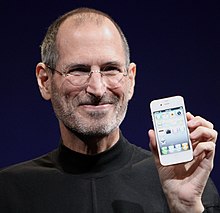
Back Џьобс, Стив Abkhazian Steve Jobs ACE Steve Jobs Afrikaans Steve Jobs ALS ስቲቭ ጆብስ Amharic Steve Jobs AN Steve Jobs ANG ستيف جوبز Arabic ستيڤ دجوبز ARY ستيف جوبز ARZ
Steve Jobs | |
|---|---|
 Jobs introducing the iPhone 4 in 2010 | |
| Born | Steven Paul Jobs[1] February 24, 1955 San Francisco, California, U.S. |
| Died | October 5, 2011 (aged 56) Palo Alto, California, U.S. |
| Resting place | Alta Mesa Memorial Park |
| Education | Reed College (no degree) |
| Years active | 1971–2011 |
| Known for |
|
| Title |
|
| Board member of |
|
| Spouse | |
| Partner | Chrisann Brennan (1972–1977) |
| Children | 4, including Lisa, Reed, and Eve |
| Relatives |
|
| Awards | Presidential Medal of Freedom (posthumous, 2022) |
| Signature | |
Steven Paul Jobs (February 24, 1955 – October 5, 2011) was an American businessman, inventor, and investor best known for co-founding the technology company Apple Inc. Jobs was also the founder of NeXT and chairman and majority shareholder of Pixar. He was a pioneer of the personal computer revolution of the 1970s and 1980s, along with his early business partner and fellow Apple co-founder Steve Wozniak.
Jobs was born in San Francisco in 1955 and adopted shortly afterwards. He attended Reed College in 1972 before withdrawing that same year. In 1974, he traveled through India, seeking enlightenment before later studying Zen Buddhism. He and Wozniak co-founded Apple in 1976 to further develop and sell Wozniak's Apple I personal computer. Together, the duo gained fame and wealth a year later with production and sale of the Apple II, one of the first highly successful mass-produced microcomputers.
Jobs saw the commercial potential of the Xerox Alto in 1979, which was mouse-driven and had a graphical user interface (GUI). This led to the development of the largely unsuccessful Apple Lisa in 1983, followed by the breakthrough Macintosh in 1984, the first mass-produced computer with a GUI. The Macintosh launched the desktop publishing industry in 1985 (for example, the Aldus Pagemaker) with the addition of the Apple LaserWriter, the first laser printer to feature vector graphics and PostScript.
In 1985, Jobs departed Apple after a long power struggle with the company's board and its then-CEO, John Sculley. That same year, Jobs took some Apple employees with him to found NeXT, a computer platform development company that specialized in computers for higher-education and business markets, serving as its CEO. In 1986, he bought the computer graphics division of Lucasfilm, which was spun off independently as Pixar.[3] Pixar produced the first computer-animated feature film, Toy Story (1995), and became a leading animation studio, producing dozens of commercially successful and critically acclaimed films.
In 1997, Jobs returned to Apple as CEO after the company's acquisition of NeXT. He was largely responsible for reviving Apple, which was on the verge of bankruptcy. He worked closely with British designer Jony Ive to develop a line of products and services that had larger cultural ramifications, beginning with the "Think different" advertising campaign, and leading to the iMac, iTunes, Mac OS X, Apple Store, iPod, iTunes Store, iPhone, App Store, and iPad. Jobs was also a board member at Gap Inc. from 1999 to 2002.[4] In 2003, Jobs was diagnosed with a pancreatic neuroendocrine tumor. He died of tumor-related respiratory arrest in 2011; in 2022, he was posthumously awarded the Presidential Medal of Freedom. Since his death, he has won 141 patents; Jobs holds over 450 patents in total.[5]
- ^ Isaacson 2011, p. 4: "Paul and Clara named their new baby Steven Paul Jobs."
- ^ "The Walt Disney Company and Affiliated Companies—Board of Directors". October 14, 2009. Archived from the original on October 14, 2009. Retrieved September 18, 2018.
- ^ Paik, Karen (November 3, 2015). To Infinity and Beyond!: The Story of Pixar Animation Studios. Chronicle Books. p. 52. ISBN 978-1-4521-4765-9.
- ^ Liedtke, Michael (October 5, 2002). "Steve Jobs resigns from Gap's board". The Berkeley Daily Planet. Archived from the original on November 14, 2012. Retrieved December 23, 2011.
- ^ "Steve Jobs Still Wins Plenty of Patents – MIT Technology Review". MIT Technology Review. Archived from the original on January 20, 2022. Retrieved June 20, 2022.